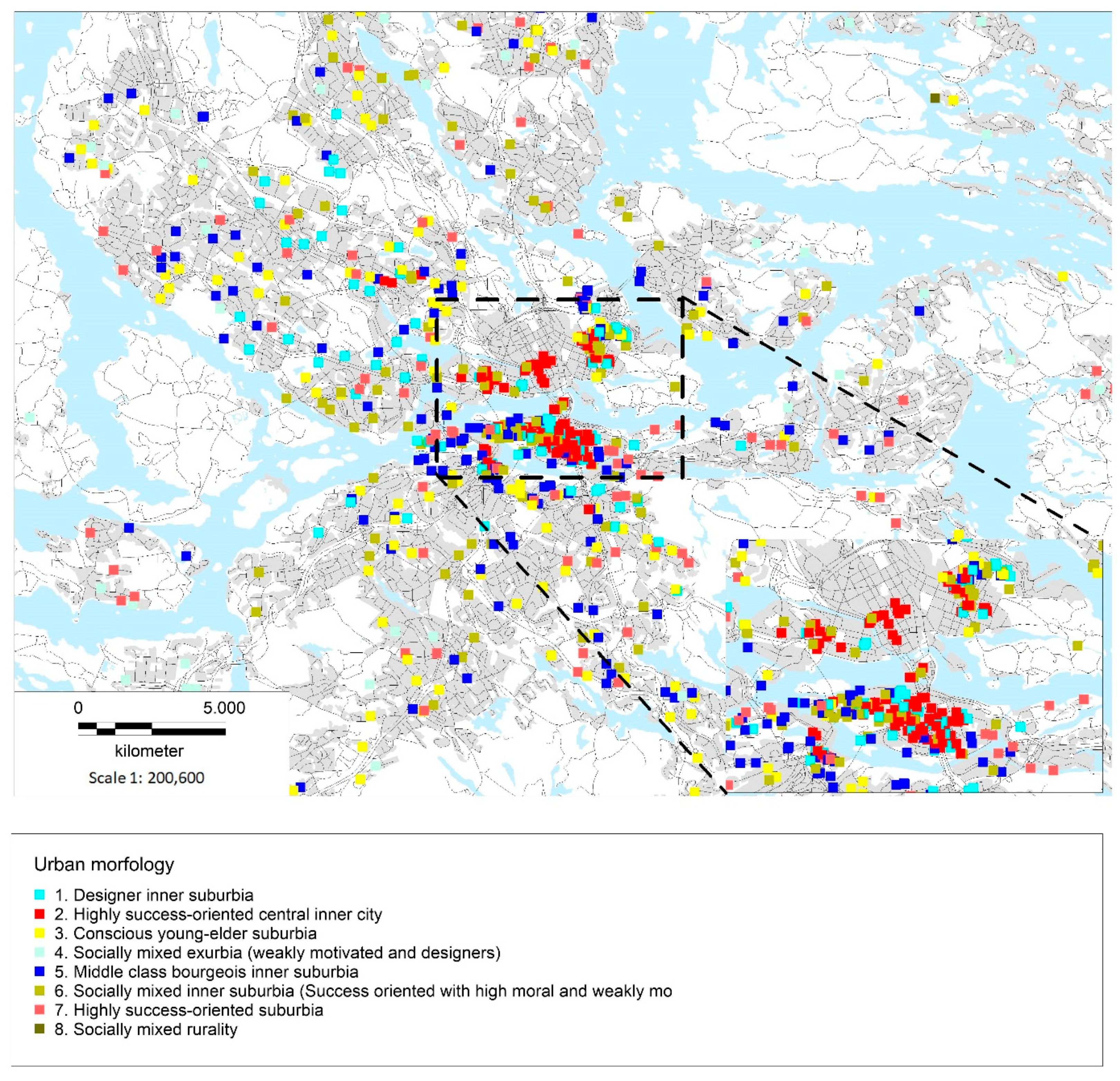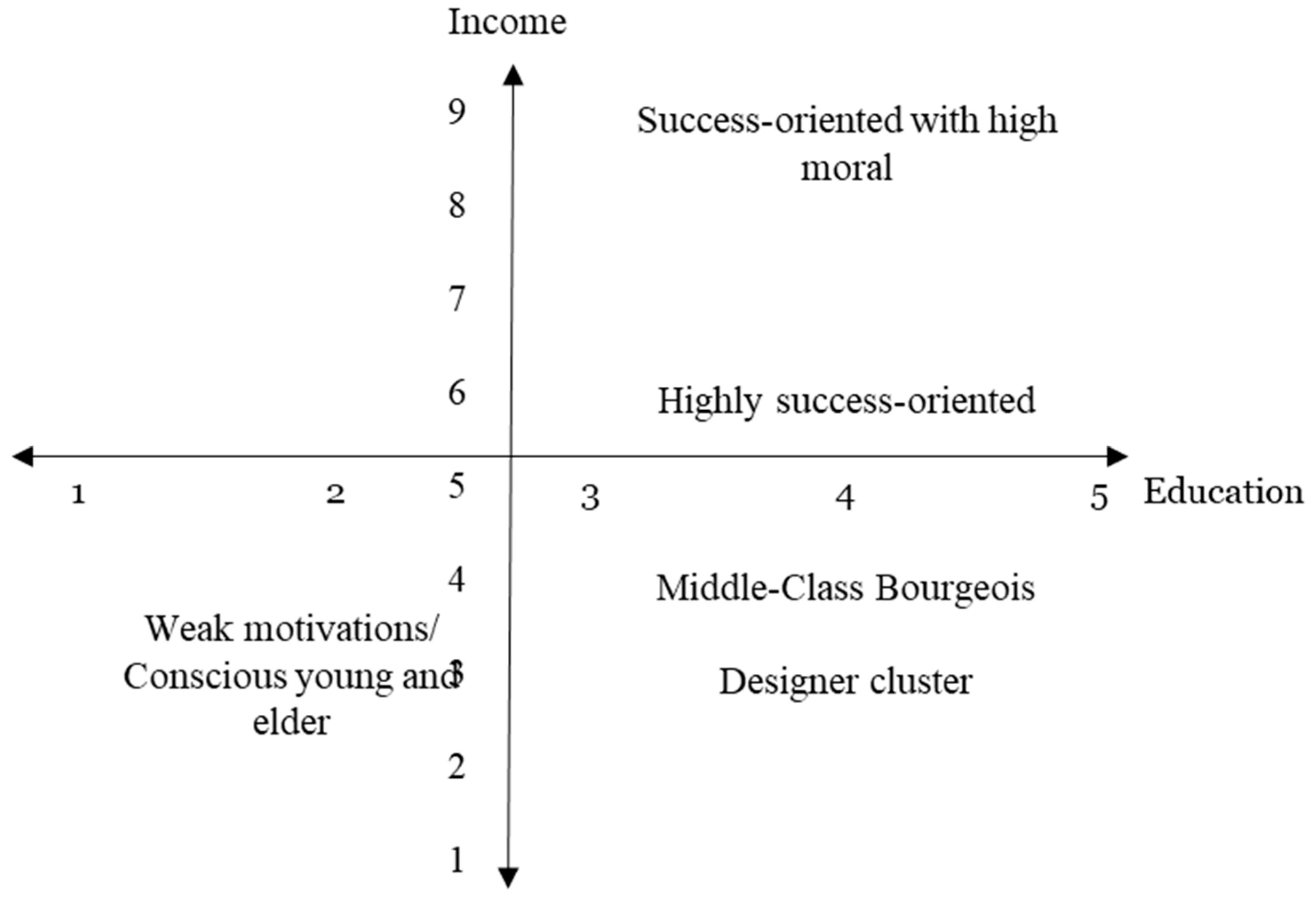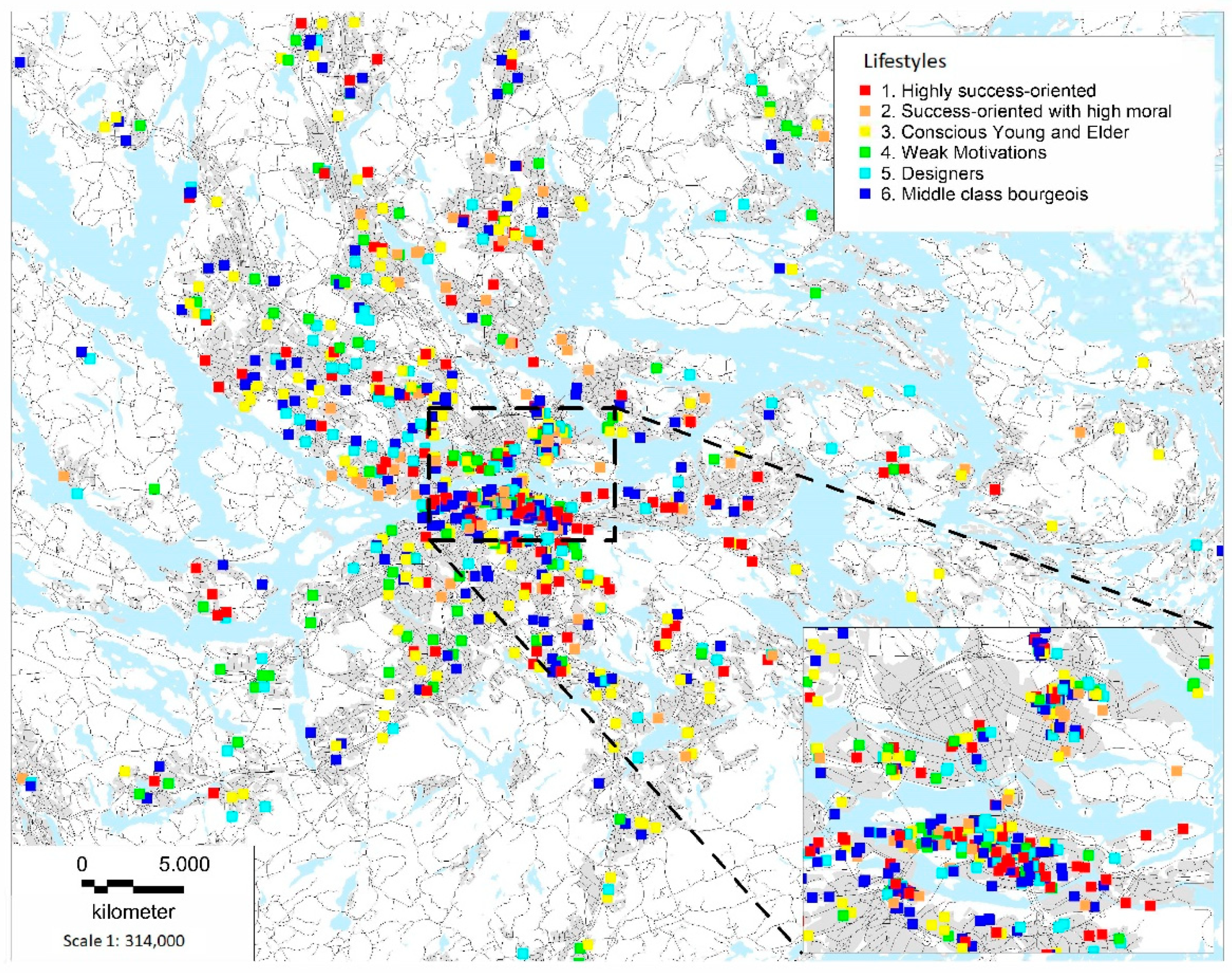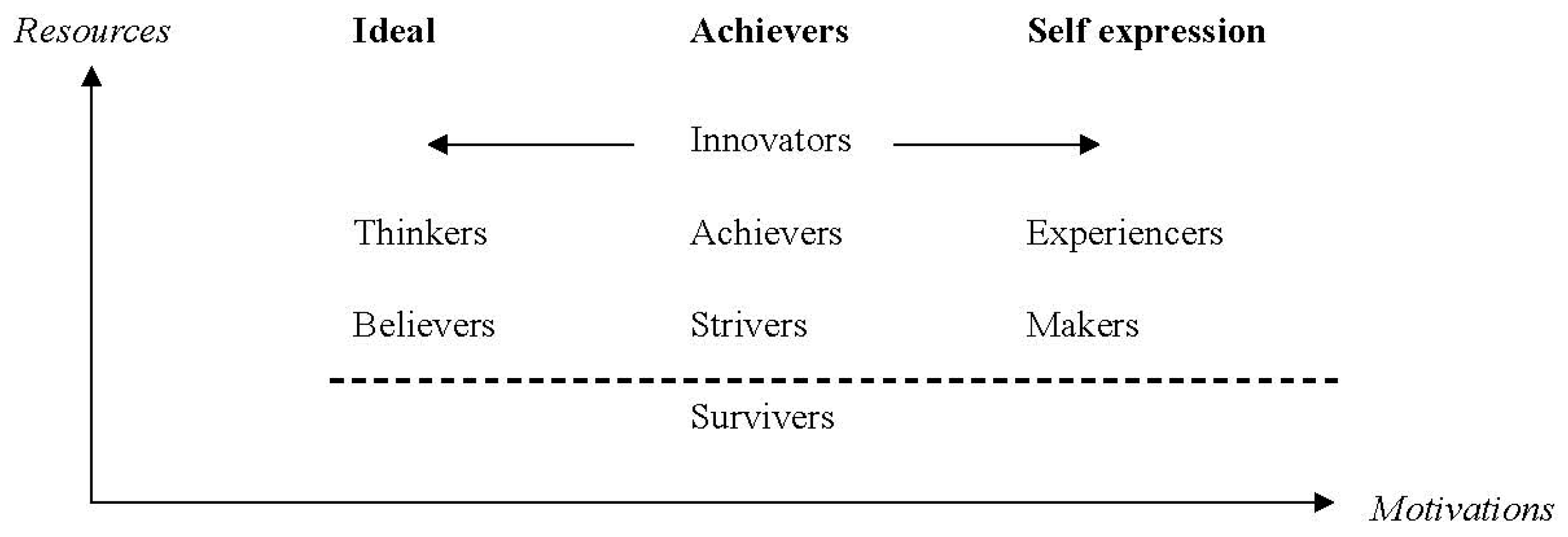Spatial Lifestyle Clusters and Access to the City: Evidence from the Stockholm Region
Abstract
1. Introduction
- Does a social stratification exist, and in that case, how does it look?
- Does a spatial social stratification exist, and in that case, how does it look?
- How is access to workplaces and service—a social infrastructure—linked to social stratification?
2. Existing Literature
3. Theoretical Framework
3.1. Social Sustainability
Under the functional aspect of mutual understanding, communicative action serves to transmit and renew cultural knowledge; under the aspect of coordinating action, it serves social integration and the establishment of solidarity; finally, under the aspect of socialization, communicative action serves the formation of personal identities. The symbolic structures of the lifeworld are reproduced by way of the continuation of valid knowledge, stabilization of group solidarity; and socialization of responsible actors. […] The interaction woven into the fabric of everyday communicative practice constitute the medium through which culture, society, and person get reproduced.Habermas [30] (pp. 137–138)
3.2. Lifestyle Theories
3.3. Urban Morphology
4. Materials and Methods
4.1. The Questionnaire
4.2. Spatial Data Processing
4.3. Factor Analysis
4.4. Cluster Analysis
5. Results
5.1. Four Lifestyle Variables
5.2. Six Lifestyle Clusters
5.3. Eight Spatial Lifestyle Clusters
6. Discussion and Summary
6.1. A Mixed Urban Environment with Clustered Tendencies
6.2. Unbalanced Provision of Social Infrastructure
6.3. Critical Assessment and Suggestions for Future Studies
6.4. Implications for Planning
Funding
Informed Consent Statement
Data Availability Statement
Conflicts of Interest
Appendix A
| Success Oriented | Designers | Sensible | Middle Class Bourgeoisie | |
|---|---|---|---|---|
| How well does following statement agree with how you view your own consumption? | ||||
| Above all, I try to find the cheaper alternatives. | −0.767 | −0.064 | 0.239 | 0.077 |
| The price is a secondary factor when I decide about buying an item. | 0.725 | 0.110 | −0.020 | 0.022 |
| I like to buy slightly more expensive and exclusive branded products (e.g., clothes) with a good reputation. | 0.668 | 0.094 | 0.407 | 0.172 |
| I like to read about e.g., the quality of a more expensive item before I buy the item | 0.136 | 0.258 | 0.760 | −0.031 |
| I try to buy goods that are proven and above all affordable | −0.286 | −0.037 | 0.671 | 0.190 |
| I often try to find some unusual alternatives (e.g., clothes) on the market that suit my personality. | 0.203 | 0.760 | 0.188 | 0.010 |
| How well does following statement fit you? | ||||
| I like to make things (incl. clothes) myself. | −0.113 | 0.696 | 0.151 | −0.128 |
| I am interested in culture (e.g.,. art, literature, film and theatre) | 0.172 | 0.636 | 0.169 | 0.209 |
| I often and happily use Wikipedia (and other encyclopaedias) | 0.050 | 0.239 | 0.487 | 0.197 |
| Work ethics, ethics, orderliness is important. | 0.017 | 0.000 | 0.087 | 0.832 |
| My reputation and prestige is important. | 0.033 | 0.036 | 0.193 | 0.812 |
| Highly Success-Oriented | Success-Oriented with High Moral | Conscious Young-Elder | Weak Motivations | Designers | Middle Class Bourgeois | |
|---|---|---|---|---|---|---|
| Achievers | 0.70 | 0.50 | −0.17 | −0.75 | 0.05 | −0.16 |
| Designers | −0.03 | −0.09 | 0.13 | −1.01 | 0.68 | 0.015 |
| Sensible | 0.09 | 0.09 | 0.26 | −1.03 | 0.19 | 0.08 |
| Middle Class B | −0.04 | 0.11 | 0.32 | −0.89 | −0.29 | 0.33 |
| Education level | 4 | 4 | 2 | 2 | 4 | 4 |
| Income level | 6 | 9 | 3 | 3 | 3 | 4 |
| Centroids | ||||||||||||||
|---|---|---|---|---|---|---|---|---|---|---|---|---|---|---|
| Cluster | DistMainC_km * | Access_ CarTr45min ** | Access_ PubTr45m *** | Diversity_ Funk **** | Density_ BefEmp_Ha ***** | Design_ AntalVag_ha ****** | ||||||||
| Order | ID | Urban Cluster Types (Concentric Zones) | Mean | Std. Deviation | Mean | Std. Deviation | Mean | Std. Deviation | Mean | Std. Deviation | Mean | Std. Deviation | Mean | Std. Deviation |
| 1 | 2 | Highly success-oriented and social mixed central inner city | 2.2 | 1.0 | 11.3 | 0.1 | 8.5 | 0.5 | 14.9 | 0.9 | 375.2 | 146.2 | 2.0 | 0.5 |
| 2 | 1 | Designer inner suburbia | 4.8 | 3.1 | 11.2 | 0.3 | 7.4 | 1.1 | 12.5 | 2.6 | 173.3 | 133.9 | 1.4 | 0.5 |
| 3 | 6 | Socially mixed inner suburbia (Success oriented with high moral and Weakly motivated) | 6.3 | 4.6 | 10.9 | 0.7 | 6.5 | 2.2 | 11.3 | 3.3 | 128.2 | 112.9 | 1.4 | 0.5 |
| 4 | 5 | Middle class bourgeois suburbia | 8.7 | 6.1 | 10.7 | 0.9 | 5.3 | 2.8 | 10.3 | 3.0 | 78.6 | 62.3 | 1.2 | 0.4 |
| 5 | 7 | Highly success-oriented suburbia | 9.8 | 5.7 | 10.4 | 1.0 | 4.5 | 2.7 | 9.1 | 2.9 | 51.5 | 41.2 | 1.2 | 0.4 |
| 6 | 3 | Conscious young-elder suburbia | 11.2 | 6.5 | 10.2 | 1.2 | 4.5 | 2.8 | 9.5 | 3.0 | 69.6 | 54.2 | 1.2 | 0.4 |
| 7 | 4 | Socially mixed exurbia (weakly motivated and designers) | 18.4 | 6.1 | 8.9 | 1.5 | 1.4 | 1.3 | 6.8 | 2.6 | 29.8 | 23.2 | 1.0 | 0.4 |
| 8 | 8 | Socially mixed rurality | 43.0 | 20.3 | 2.6 | 2.2 | 0.1 | 0.1 | 3.8 | 3.0 | 14.2 | 17.9 | 0.8 | 0.5 |
| Cluster Number of Case | ||||||||
|---|---|---|---|---|---|---|---|---|
| Highly Success-Oriented | Success-Oriented with High Moral | Conscious Young-Elder | Weak Motivations | Designers | Middle Class Bourgeois | |||
| Order | ID | Urban Cluster Types (Concentric Zones) | Percent | Percent | Percent | Percent | Percent | Percent |
| 1 | 2 | Highly success-oriented and socially mixed central inner city | 31% | 0% | 13% | 2% | 1% | 15% |
| 2 | 1 | Designer inner suburbia | 0% | 0% | 0% | 0% | 64% | 0% |
| 3 | 6 | Socially mixed inner suburbia (Success oriented with high moral and Weakly motivated) | 0% | 90% | 0% | 53% | 0% | 0% |
| 4 | 5 | Middle class bourgeois suburbia | 0% | 0% | 0% | 0% | 0% | 73% |
| 5 | 7 | Highly success-oriented suburbia | 66% | 0% | 0% | 0% | 0% | 0% |
| 6 | 3 | Conscious young-elder suburbia | 0% | 0% | 78% | 0% | 0% | 0% |
| 7 | 4 | Socially mixed exurbia (weakly motivated and designers) | 0% | 0% | 0% | 35% | 29% | 0% |
| 8 | 8 | Socially mixed rurality (all lifestyles) | 3% | 10% | 8% | 10% | 6% | 12% |

References
- Frantzeskaki, N.; Broto, V.C.; Coenen, L.; Loorbach, D. (Eds.) The Dynamics and Opportunities of Sustainability Transitions in Cities. In Urban Sustainability Transitions; Routledge: London, UK, 2017; pp. 1–19. [Google Scholar]
- Swedish Environmental Protection Agency. De Svenska Miljömålen; Arkitektkopia AB: Bromma, Sweden, 2018. [Google Scholar]
- TRF, Tillväxt-Och Regionplaneförvaltningen. Regional Utvecklingsplan för Stockholmsregionen RUFS 2050; DanagårdsLitho: Stockholm, Sweden, 2018. [Google Scholar]
- Serageldin, I. Sustainability as opportunity and the problem of social capital. Brown J. World Aff. 1996, 3, 187–203. [Google Scholar]
- Serageldin, I.; Grootaert, C. Defining social capital: An integrating view. In Evaluation & Development the Institutional Dimension; Picciotto, R., Wiesner, E., Eds.; Routledge: New York, NY, USA, 2017; pp. 201–217. [Google Scholar]
- Klinenberg, E. Palaces for the People: How Social Infrastructure Can Help Fight Inequality, Polarization, and the Decline of Civic Life; Crown Publishing Group: New York, NY, USA, 2018. [Google Scholar]
- Latham, A.; Layton, J. Social infrastructure: Why it matters and how urban geographers might study it. Urban Geogr. 2022, 43, 659–668. [Google Scholar] [CrossRef]
- Teriman, S.; Yigitcanlar, T.; Mayere, S. Social infrastructure planning and sustainable community: Example from south east Queensland, Australia. In Proceedings of the Business and Social Science Research Conference, Auckland, New Zealand, 12–13 December 2011; Jahan, N., Ed.; World Business Institute Australia: Chippendale, Australia, 2011; pp. 1–12. [Google Scholar]
- Yhee, H.; Kim, S.; Kang, S. GIS-Based Evaluation Method for Accessibility of Social Infrastructure Facilities. Appl. Sci 2021, 11, 5581. [Google Scholar] [CrossRef]
- Mitchell, A. The Nine American Lifestyles: Who We Are and Where We’re Going; Warner Books: New York, NY, USA, 1984. [Google Scholar]
- Van Acker, V.; Goodwin, P.; Witlox, F. Key research themes on travel behavior, lifestyle, and sustainable urban mobility. Int. J. Sustain. Transp. 2016, 10, 25–32. [Google Scholar] [CrossRef]
- Neuman, M.; Smith, S. City Planning and Infrastructure: Once and Future Partners. J. Plan. Hist. 2019, 9, 21–42. [Google Scholar] [CrossRef]
- Vitiello, D. Planning for infrastructure: Lifelines, mobility, and urban development. In The Routledge Handbook of Planning History; Hein, C., Ed.; Routledge: New York, NY, USA, 2017; pp. 325–337. [Google Scholar]
- Atkinson, R.; Jacobs, K. Housing, Inequality and Sociology: A Comment on Pragmatic Socioeconomics. Hous. Theory Soc. 2022, 39, 147–150. [Google Scholar] [CrossRef]
- Fabris, L.M.F.; Camerin, F.; Semprebon, G.; Balzarotti, R.M. New Healthy Settlements Responding to Pandemic Outbreaks: Approaches from (and for) the Global City. Plan J. 2020, 5, 385–406. [Google Scholar] [CrossRef]
- Manika, S. Transforming Vacant Commercial Spaces: From Localized Hotspots of Urban Shrinkage to “Smart” Co-Working Places. Open J. Soc. Sci. 2020, 8, 86–97. [Google Scholar] [CrossRef]
- Cardoso, R.; Sobhani, A.; Meijers, E. The cities we need: Towards an urbanism guided by human needs satisfaction. Urban Stud. 2022, 59, 2638–2659. [Google Scholar] [CrossRef]
- Gastaldi, F.; Camerin, F. Brownfield infrastructures. In The Elgar Companion to Urban Infrastructure Governance; Finger, M., Yanar, N., Eds.; Edward Elgar Publishing Limited: Northampton, MA, USA, 2022; pp. 165–180. [Google Scholar]
- Davern, M.; Gunn, L.; Whitzman, C.; Higgs, C.; Giles-Corti, B.; Simons, K.; Villanueva, K.; Mavoa, S.; Roberts, R.; Badland, H. Using spatial measures to test a conceptual model of social infrastructure that supports health and wellbeing. Cities Health 2017, 1, 194–209. [Google Scholar] [CrossRef]
- Latham, A.; Layton, J. Social infrastructure and the public life of cities: Studying urban sociality and public spaces. Geogr. Compass 2019, 13, e12444. [Google Scholar] [CrossRef]
- Higgs, C.; Badland, H.; Simons, K.; Knibbs, L.D.; Giles-Cort, B. The Urban Liveability Index: Developing a policy-relevant urban liveability composite measure and evaluating associations with transport mode choice. Int. J. Health Geogr. 2019, 18, 14. [Google Scholar] [CrossRef]
- UN, United Nations. Sustainable Development Goals. Available online: https://www.un.org/sustainabledevelopment/sdg-moment/ (accessed on 1 January 2020).
- OECD. Handbook on Constructing Composite Indicators: Methodology and User Guide. 2008. Available online: http://www.oecd.org/sdd/42495745.pdf (accessed on 22 August 2022).
- Nicoletti, L.; Sirenko, M.; Verma, T. Disadvantaged Communities Have Lower Access to Urban Infrastructure. EPB Urban Anal. City Sci. 2022, 0, 1–19. [Google Scholar] [CrossRef]
- Sun, X.; Wang, W.; Sun, T.; Wang, Y.P. Understanding the Living Conditions of Chinese Urban Neighborhoods through Social Infrastructure Configurations: The Case Study of Tianjin. Sustainability 2018, 10, 3243. [Google Scholar] [CrossRef]
- Williams, P.; Pocock, B. Building ‘community’ for different stages of life: Physical and social infrastructure in master planned communities. Community Work. Fam. 2010, 13, 71–87. [Google Scholar] [CrossRef]
- O’Donnell, D.; Gubbins, C.; McGuire, D.; Mølbjerg Jørgensen, K.; Henriksen, L.B.; Garavan, T.N. Social capital and HRD: Provocative insights from critical management studies. Adv. Dev. Hum. Resour. 2007, 9, 413–435. [Google Scholar] [CrossRef]
- Glanville, J.; Paxton, P. How do we learn to trust? A confirmatory tetrad analysis of the Sources of generalized trust. Soc. Psychol. Q. 2007, 70, 230–242. [Google Scholar] [CrossRef]
- Adolphson, M. Främling i konsumtionsstaden. In Det Förflutna i Framtidens Stad; Olsson, K., Nilsson, D., Haas, T., Eds.; Nordic Academic Press: Lund, Sweden, 2014; pp. 19–36. [Google Scholar]
- Habermas, J. The Theory of Communicative Action. Vol. 2, Lifeworld and System: A Critique of the Functionalist Reason; Beacon Press: Boston, MA, USA, 1987. [Google Scholar]
- Habermas, J. Civil society and political public spheres. In Contemporary Sociological Theory; Calhoun, C., Gerties, J., Moody, J., Pfaff, S., Virk, I., Eds.; Blackwell Publishing: Malden, MA, USA, 2007; pp. 388–407. [Google Scholar]
- Alvesson, M. Knowledge Work and Knowledge Intensive Firms; Oxford University Press: Oxford, UK, 2004. [Google Scholar]
- Hildago, M.C.; Hernandez, C. Place attachments: Conceptual and empirical questions. J. Environ. Psychol. 2001, 21, 273–281. [Google Scholar]
- McCann, P. Urban and Regional Economics; Oxford University Press: Oxford, UK, 2013. [Google Scholar]
- Kropf, K. The Handbook of Urban Morphology; Wiley: West Sussex, UK, 2017. [Google Scholar]
- Florida, R. Cities and the Creative Class; Routledge: New York, NY, USA, 2005. [Google Scholar]
- Glaeser, E.L.; Kolko, J.; Saiz, A. Consumer city. J. Econ. Geogr. 2001, 1, 27–50. [Google Scholar] [CrossRef]
- Glaeser, E.L.; Gottlieb, J.D. Urban resurgence and the consumer city. Urban Stud. 2006, 43, 1275–1299. [Google Scholar] [CrossRef]
- Pisman, A. Lifestyles as Centrifugal and Centripetal Forces in the Polycentric Network City of Flanders. Available online: https://biblio.ugent.be/publication/379900/file/460473.pdf (accessed on 1 February 2022).
- Burgess, E.W.; Park, R.E. The City; University of Chicago Press: Chicago, IL, USA, 1925. [Google Scholar]
- Hoyt, H. The Structure and Growth of Residential Neighborhoods in American Cities; U.S. Government Publishing Office: Washington, DC, USA, 1939. [Google Scholar]
- Harris, C.; Ullman, E. The nature of cities. Ann. Am. Acad. Political Soc. Sci. 1945, 242, 7–17. [Google Scholar] [CrossRef]
- Pisman, A. De Verkenning Van Het Leefstijlconcept in Een Subjectgerichte Ruimtelijke Planningsstrategie [Exploration of the Lifestyle Concept in a Subject-Oriented Spatial Planning Strategy]. Ph.D. Thesis, Ghent University, Ghent, Belgium, 2012. [Google Scholar]
- Munters, Q.J. Bestaan leefstijlen (nog) wel? [Do lifestyles (still) exist?]. Sociol. Gids 1992, 39, 179–185. [Google Scholar]
- Kitamura, R. Life-style and travel demand. Transportation 2009, 36, 679–710. [Google Scholar] [CrossRef]
- Marx, K.; Engels, F. Manifesto of the communist party. In Classical Sociological Theory; Calhoun, C., Gerties, J., Moody, J., Pfaff, S., Virk, I., Eds.; Blackwell Publishing: Malden, MA, USA, 2007; pp. 96–111. [Google Scholar]
- Marx, K. Capital a Critique of Political Economy. Vol. I, Book One, the Process of Production of Capital; Electric Book: London, UK, 1867. [Google Scholar]
- Simmel, G. Group expansion and development of individuality. In Classical Sociological Theory; Calhoun, C., Gerties, J., Moody, J., Pfaff, S., Virk, I., Eds.; Blackwell Publishing: Malden, MA, USA, 2007; pp. 300–314. [Google Scholar]
- Bourdieu, P. Social space and symbolic space. In Contemporary Sociological Theory; Calhoun, C., Gerties, J., Moody, J., Pfaff, S., Virk, I., Eds.; Blackwell Publishing: Malden, MA, USA, 2007; pp. 267–276. [Google Scholar]
- Weber, M. The distribution of power within the political community: Class, status, party. In Classical Sociological Theory; Calhoun, C., Gerties, J., Moody, J., Pfaff, S., Virk, I., Eds.; Blackwell Publishing: Malden, MA, USA, 2007; pp. 247–255. [Google Scholar]
- SBI, Strategic Business Insights. 2020. US Framework and VALS™ Types. Available online: http://www.strategicbusinessinsights.com/vals/ustypes.shtml (accessed on 1 January 2020).
- Guns, B. Copyright by Strategic Business Insights, 2020. US Framework and VALS™ Types. Used with Permission. 2022. Available online: http://www.strategicbusinessinsights.com/vals/ustypes.shtml (accessed on 1 May 2020).
- Antoniou, C.; Shach-Pinsly, D.; Sprumont, F. A typology of urban analysis models. In Digital Social Networks and Travel Behaviour in Urban Environments; Plaut, P.O., Shach-Pinsly, D., Eds.; Routledge: New York, NY, USA, 2019; pp. 135–155. [Google Scholar]
- Sassen, S. The State and the Global City: Notes towards a Conception of Place-Centered’ Governance. Compet. Chang. 1995, 1, 31–50. [Google Scholar] [CrossRef]
- Gleeson, B. Critical Commentary. The Urban Age: Paradox and Prospect. Urban Stud. 2012, 49, 931–943. [Google Scholar] [CrossRef]
- RTK, Regionplane-Och Trafikkontoret. Livsstilar Och Konsumtionsmönster i Stockholmsregionen: Ett Regionalt Utvecklingsperspektiv; Stockholms Läns Landsting: Stockholm, Sweden, 2008. [Google Scholar]
- SLU. Access to Zeus.Slu.Se. Available online: https://maps.slu.se. (accessed on 1 May 2020).
- Adolphson, M. Urbanmorfologi, Livsstilar Och Resebeteende; KTH: Stockholm, Sweden, 2021; ISBN 978-91-7873-993-6. [Google Scholar]
- Enkätfabriken. Sankt Eriksgatan 19, 112 39 Stockholm. 2019. Available online: https://www.enkatfabriken.se/ (accessed on 1 June 2022).
- Ewing, R.; Cervero, R. Travel and the built environment. Transp. Res. Rec. 2001, 1780, 87–114. [Google Scholar] [CrossRef]
- Ewing, R.; Cervero, R. Travel and the built environment. A meta analysis. J. Am. Plan. Assoc. 2010, 76, 265–294. [Google Scholar] [CrossRef]
- Ewing, R.; Cervero, R. “Does Compact Development Make People Drive Less?” The Answer Is Yes. J. Am. Plan. Assoc. 2017, 83, 19–25. [Google Scholar] [CrossRef]
- Handy, S. Thoughts on the meaning of Mark Steven’s meta-analysis. J. Am. Plan. Assoc. 2017, 83, 26–28. [Google Scholar] [CrossRef]
- Stevens, M. Does compact development make people drive less? J. Am. Plan. Assoc. 2017, 83, 7–18. [Google Scholar] [CrossRef]
- Mokhtarian, P.L.; Cao, X.J. Examining the Impacts of Residential Self-Selection on travel behaviour: A Focus on methodologies. Transp. Res. Part B Methodol. 2008, 42, 204–228. [Google Scholar] [CrossRef]
- Bamberg, S.; Schmidt, P. Incentives, morality, or habit? Predicting students’ car use for university routes with the models of Ajzen, Schwartz, and Triandis. Environ. Behav. 2003, 35, 264–285. [Google Scholar] [CrossRef]
- Bamberg, S.; Rollin, P.; Schulte, M. Local mobility culture as injunctive normative beliefs—A theoretical approach and a related measurement instrument. J. Environ. Psychol. 2020, 71, 1–15. [Google Scholar] [CrossRef]
- Triandis, H.C. Values, attitudes, and interpersonal behavior. In Nebraska Sympostium on Motivation; Howe, H.E., Ed.; University of Nebraska Press: London, UK, 1980; pp. 195–259. [Google Scholar]
- Klinger, T.; Lanzendorf, M. Moving between mobility cultures: What effects the travel behavior of new residents? Transportation 2016, 43, 243–271. [Google Scholar] [CrossRef]
- Lanzendorf, M. Mobility styles and travel behavior: Application of a lifestyle approach to leisure travel. Transp. Res. Rec. 2002, 1807, 163–173. [Google Scholar] [CrossRef]
- Openshaw, S. The Modifiable Areal Unit Problem (Concepts and Techniques in Modern Geography); No. 38; Geo Books: Northwich, UK, 1983. [Google Scholar]
- LeSage, J.; Pace, R.K. Introduction to Spatial Econometrics; Chapman and Hall/CRC: Boca Raton, FL, USA, 2009. [Google Scholar]
- O’Sullivan, D.; Unwin, D. Geographic Information Analysis; J. Wiley Cop: New York, NY, USA, 2003. [Google Scholar]
- Adolphson, M. Kernel densities and mixed functionality in a multicentred urban region. Environ. Plan. B Plan. Des. 2010, 37, 550–566. [Google Scholar] [CrossRef]
- Transport and System Analysis, KTH (2020). Available online: https://www.kth.se/en/som/avdelningar/sek (accessed on 1 February 2020).
- Hair, J.F.; Black, W.C.; Babin, B.J.; Anderson, R.E. Multivariate Data Analysis; Prentice Hall: Englewood Cliffs, NJ, USA, 2014. [Google Scholar]


| How well does following statement fit you? |
| I like to make things (inclusive clothes) myself. |
| I am interested in culture (e.g., art, literature, film and theatre) |
| I often and happily use Wikipedia (and other encyclopedias) |
| Work ethics, ethics, orderliness are important. |
| My reputation and prestige are important. |
| How well does following statement agree with how you view your own consumption? |
| Above all, I try to find the cheaper alternatives. |
| The price is a secondary factor when I decide about buying an item. |
| I like to buy slightly more expensive and exclusive branded products (e.g., clothes) with a good reputation. |
| I like to read about e.g., the quality of a more expensive item before I buy the item. |
| I try to buy goods that are proven and above all affordable. |
| I often try to find some unusual alternatives (e.g., clothes) on the market that suit my personality. |
Publisher’s Note: MDPI stays neutral with regard to jurisdictional claims in published maps and institutional affiliations. |
© 2022 by the author. Licensee MDPI, Basel, Switzerland. This article is an open access article distributed under the terms and conditions of the Creative Commons Attribution (CC BY) license (https://creativecommons.org/licenses/by/4.0/).
Share and Cite
Adolphson, M. Spatial Lifestyle Clusters and Access to the City: Evidence from the Stockholm Region. Sustainability 2022, 14, 14261. https://doi.org/10.3390/su142114261
Adolphson M. Spatial Lifestyle Clusters and Access to the City: Evidence from the Stockholm Region. Sustainability. 2022; 14(21):14261. https://doi.org/10.3390/su142114261
Chicago/Turabian StyleAdolphson, Marcus. 2022. "Spatial Lifestyle Clusters and Access to the City: Evidence from the Stockholm Region" Sustainability 14, no. 21: 14261. https://doi.org/10.3390/su142114261
APA StyleAdolphson, M. (2022). Spatial Lifestyle Clusters and Access to the City: Evidence from the Stockholm Region. Sustainability, 14(21), 14261. https://doi.org/10.3390/su142114261





